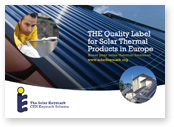Brochure
Solar Keymark brochure:

The Solar Keymark Brochure is available in several languages:
• Portuguese 2017 version (PT)
• Macedonian 2017 version (MK)
• Chinese 2010 version (Mandarin CN)
Collector performance parameters
The collector performance is described by the equation for the power output q:
- q = A*(n0*G - a1*dT - a2*dT²) [W]
with the operation conditions:
- G : Solar irradiance on collector plane [W/m²]
- dT: Temperature difference between collector mean fluid temperature and ambient air temperature [K] (Kelvin)
and the collector performance parameters:
- n0 : Optical efficiency
- Combined efficiency of the transparent cover and the absorber [-]
- a1 : 1st order heat loss coefficient
- Heat loss cofficient at collector fluid temperature equal to ambient temperature [W/K]
- a2 : 2nd order heat loss coefficient
- Temperature dependent term of heat loss coefficient [W/K²]
- The heat loss coefficient of a collector depends on the temperature. High values of a2 indicates large temperature influence
- The higher the value of a2 the more "hookednosed" the power/efficiency curve)
and the collector area:
- A: Collector area corresponding to the performance parameters
- Two sets of performance parameters are determined according to European Standard EN12975-2 - one set corresponding to the absorber area and one set corresponding to the aperture area. It is important to use corresponding area / parameters. Normally the aperture area is used, which is: The area through which the solar radiation enters the solar collector
Collector efficiency curves
Using the simple tools below, you can put in data for a collector and see the efficiency curve - and compare with typical collectors:
- Compare your collector with typical collectors: Download Excel-file
- Compare your collector with typical collectors: Run interactive file (requires Microsoft® Internet Explorer 4.01 Service Pack 1 (SP1) or later and the Microsoft Office XP Web Components)
CE-marking related to Pressure Equipment Directive (PED)
As solar collectors are pressurized, the question arises if they are touched by the regulations of the EU pressure equipment directive (PED).
According to the rules and guidelines referred below:
- Large collector modules with PS*V BIGGER THAN 50 bar*litres SHALL be CE-marked in relation with the PED
- Normal collector modules with PS*V LOWER THAN 50 bar*litres CAN NOT be CE-marked in relation to the PED
In Guideline 2/23 of March 31st, 2006 to the Pressure equipment directive 97/23/EC by the Commission's Working Group "Pressure", it is clarified that: "A typical solar panel would be classified as Article 3, paragraph 3 equipment, due to the maximum allowable pressure and volume" - see Annex II and the figure below:

PS: Maximum allowed pressure in bars; V: Volume (fluid content) in litres
It is seen that far most collectors are covered by the Article 3 Paragraph 3, stating: "Such equipment and/or assemblies must not bear the CE marking ...".
However, in some cases CE-marking of solar thermal collectors is obligatory according to the curves above (large collector modules):
- Collector volume in litres multiplied by the max. allowable pressure in bars > 50 litre*bar: Category I - Conformity Assessment Procedures: Module A applies
- Collector volume in litres multiplied by the max. allowable pressure in bars > 200 litre*bar: Category II - Conformity Assessment Procedures: Modules A1, D1, E1 applies
PS. In accordance with clause (5) of the preface of the PED, not a collector array, but a single collector has to be considered.
CE-marking related to Directive 89/106/EEC, Construction Product Directive (CPD)
CE-marking of solar collectors related to the Construction Product Directive (CPD) is under preparation.
The CE-marking will cover the following characteristics for solar thermal collectors in buildings.:
- Mechanical resistance to climatic loads (wind, snow, ...)
- Fire safety (e.g. initiation, reaction to fire, risk to adjacent elements, ..., as relevant)
- Weather tightness (when relevant - i.e. for roof integrated or façade integrated collectors)
Attestation of conformity according to CPD Annex III.2.(ii), econd possibility:
- initial type-testing of the product by an approved laboratory
- factory production control
CE-marking should go hand in hand with Keymarking:
- CE-marking being the manufacturer declared (lower level) quality assurance scheme
- Keymarking being the 3rd party certified (higher level) quality assurance scheme
t is expected that this CE-marking will be inforce in 2014-15
Solar Keymark products
Solar Keymark News
-
Solar Certification Fund: 12th call
Brussels, November 18th 2020 – The Solar Certification Fund (SCF) launched its 12th call for proposals to continue to provide regular and reliable support for:
Read more...


